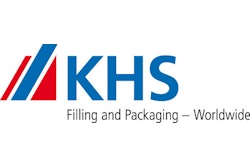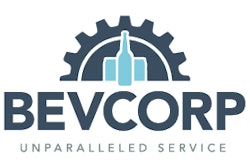Coke may be “the real thing,” but The Coca-Cola Company, Atlanta, GA, has found plenty of other innovative and successful ways to bring refreshment to consumers globally. Today, the company markets more than 3,500 beverage products in 200 countries around the world. Under The Coca-Cola System, it is the job of the company’s 300-plus bottling partners to produce, package, and distribute the ever evolving portfolio of Coca-Cola products and packages.
In Baton Rouge, LA, Coca-Cola’s largest privately held U.S. bottler—Coca-Cola Bottling Company United, Inc., based in Birmingham, AL—is meeting the challenges posed by growing product and package differentiation through a brand-new, state-of-the-art plant designed with the future in mind.
“We decided to build a new, larger facility, a more modern facility, with a lot of flexibility in it,” explains Baton Rouge Coca-Cola Bottling’s operations manager, Mike Lurker. “We needed a plant with higher speeds and state-of-the-art technology that could not only take care of our immediate needs, but also our needs 20 to 25 years down the road, as well.”
The 781,000-sq-ft LEED-certified (see sidebar on p. 55) Greenfield plant began operation in October 2008 and now runs four packaging lines that produce 4.5 million 8-oz servings/day. The facility handles 400 SKUs, including products under the Coca-Cola and Dr. Pepper names, and under Southern U.S. brand Big Red. The Coca-Cola products distributed from the site include soft drinks, energy beverages, juices, waters, sports drinks, teas, and more. Of those 400 SKUs, 120 are produced and packaged at the plant.
Built into the “foundation” of the new facility, flexible equipment selections, a streamlined plant-floor layout, and a new production monitoring system keep the myriad of beverage products and packages flowing efficiently through the plant.
Growing demand spurs expansion
Coca-Cola Bottling Company United has been a fixture in Baton Rouge for more than 100 years, supporting select markets in Louisiana and Mississippi. In 2007, the company found itself outgrowing its 27-acre plant. Not only was the beverage industry’s overall growth putting a strain on the facility’s capacity, but also an increase in the Baton Rouge population due to consumers displaced by Hurricane Katrina spurred the need for expansion. With no physical space available in which to expand, Coca-Cola Bottling built a new plant on 112 acres, with an option to purchase 20 more, if needed.
“There was just no way around it,” says Lurker of the decision. “What was required was more land than we had, and we had to upgrade the packaging technology. In the world of Coke, packaging requirements change at a moment’s notice, and the capabilities of the equipment we had weren’t conducive to handling new packages.”
The plant was equipped with four packaging lines—one canning, two PET, and one hot-fill PET—along with the infrastructure for two additional packaging lines. Of all the machinery installed, only the can filler and the can multipacker came from the previous plant.
Given a blank slate to work with for plant-floor layout, Coca-Cola Bottling designed the facility for efficient flow, from raw materials in, to full product out. Ninety-eight docks surround the production area, with trucks delivering raw materials directly to the lines on which they will be used. PET lines run parallel to one another, allowing one operator to supervise more than one piece of equipment when required. “It’s all set up and designed for flexible staffing,” says Lurker.
Finished cases are palletized in the middle of the warehouse, creating what Lurker calls “the Alaskan pipeline” of case conveying. “That allows for full product flow through the building,” he explains.
As mentioned earlier, the key consideration for new packaging equipment was flexibility. “Our rule of thumb is if you are buying new, don’t buy for today, buy for whatever you can possibly foresee,”Lurker says. The other requirement, he adds, was that new equipment match the speed of the filler: “It’s pretty industry-standard, but you always want to have 20-percent pull-away from your filler from each piece of equipment.”
Four lines produce 120 skus
Demonstrating the breadth of the plant’s packaging capabilities:
• Line 1 handles 12-oz soft drink cans at 1,800/min, packaging them in a range of case sizes
• Line 2 fills 1- and 2-L and 20-oz PET bottles of sparkling (or carbonated) beverages at up to 800/min
• Line 3 accommodates 12- and 20-oz and 0.5-L PET bottles of both sparkling beverages and Dasani water at speeds to 800/min
• Line 4 hot-fills 20- and 32-oz PET bottles of Powerade sports drink at speeds to 800/min
According to Lurker, at the Baton Rouge plant, as at most Coke plants, many times it’s what you do with the can or bottle after it is filled that requires the greatest packaging flexibility. For example, on Line 1, after can bodies from Ball Corp. are filled on a Crown Cork & Seal 130-valve filler, supplied by Bevcorp, and sealed with Ball can ends on an Angelus seamer from PneumaticScaleAngelus, they are inspected using filtec Model FT-50 inspection equipment, after which they can be multipacked in a variety of pack sizes. Two machines handle secondary packaging: A Hi-Cone multipacker creates six-packs with ring carriers, while a Graphic Packaging Intl. multipacker can load cans in 12-, 20-, or 24-pack cases. Operators change over the GPI Quickflex Model 600C multipacker approximately three times each day, says Lurker, with each changeover taking just 15 minutes: “It’s just a matter of doing some quick changeovers on-the-fly to put different wedges and different materials in.”
Filled cases are carried by Sentry conveyors to the palletizing area (Sentry Equipment & Erectors, Inc. supplied the majority of the conveyors in the plant. Four Ryson [www.ryson.com] spiral conveyors are also used). Because Line 1 uses two high-level palletizers from T-Tek Material Handling, both the Hi-Cone and the GPI multipacker can be run simultaneously, feeding one or the other palletizer. Once a pallet is created, it is stretch-wrapped on an in-line Wulftec WCRT-200.
In the case of Lines 2 and 3, which Lurker says are almost mirror images of one another, considerable flexibility is also required in the filling operation due to the range of bottle sizes being run on the lines. “Every different bottle shape and size that you run requires different handling through a filler, especially at the speeds we are running,” he explains. “We have to have changeparts for each bottle type that we run.”
Lines 2 and 3 use Krones Mecafill 120-valve neck-hanging fillers. Handling bottles by the neck allows for flexibility in bottle length. The machines’ filling valves are computer-actuated for accuracy, and the units are electronically controlled and monitored at all times, adding to flexibility and ease of changeover, comments Lurker. Krones cappers, fed by Sidel CF2024 cap feeders, seal the bottles after they are filled.
Changeover flexibility is also critical during labeling. “Within each bottle size, there are different bottle types,” explains Lurker. “For example, for a 20-ounce bottle, we run the 20-ounce Coke bottle, the 20-ounce ‘angle’ bottle for Dr. Pepper, and then a bottle that we call the bulk bottle, or the multipurpose bottle. Each one of these has subtle differences that require different changeparts.”
On each line (2 and 3), Coca-Cola Bottling installed two SACMI Opera 300 RF 24T/SR 700-bottle/min roll-fed labelers. “We selected the SACMI labelers for the speeds they could achieve reliably and their ability to handle these types of bottles,” says Lurker.
Lines 2 and 3 both offer flexibility in secondary packaging, as well. Bottles run on Line 2 are fed to a Hartness 2650 continuous-motion case packer that places single-serve bottles into reusable plastic shells, or crates.
On Line 3, there are three choices for secondary packaging. Bottles can be packed loose in plastic shells using a Hartness 825 drop case packer. A Hi-Cone 891M3 high-volume oriented ring applicator can group bottles in six or eight packs with ring carriers, after which they are placed into reusable plastic shells. Or, bottles can be directed to a Kisters TSP 080V tray packer/shrink wrapper from KHS.
Despite multiple secondary packaging options on these lines, 2 and 3 only have one palletizer each, both from T-Tek Material Handling. In-line stretch wrappers from Wulftec stretch-wrap finished pallets.
Hot-fill expertise is critical
More than flexibility, the key to Line 4 is expertise in hot-filling to ensure product sterility while maintaining product integrity. Coca-Cola Bottling uses a KHS Innofill NVH 100 filler to fill bottles with beverage heated to a minimum of 180°F. A complex pasteurization-loop control system from Cadence Technologies automates the process, ensuring product is heated to the correct temperature without being burned. “If anything along that process has a deviation outside the setpoint, it shuts down,” says Lurker.
In contrast to most fillers, which use volumetric filling, the state-of-the-art 100-valve KHS filler electronically meters each valve for fill control. “Independent valve accuracy helps you with yield controls and with quality,” comments Lurker. “You can actually dial in each valve independently on the fill mechanism.”
The filler is situated in an enclosed room, which also houses the capper—a Fowler/Zalkin ZTCT-25/900. Caps are applied immediately following filling, after which bottles are inverted, allowing the heated product to sterilize the cap, as well.
Bottles are then turned upright and are carried by conveyor to a G.C. Evans cooler, which cools the product to ambient temperature. Two Krones Contiroll HS (High-Speed) roll-fed shrink labelers then apply labels to the bottles, and a heat tunnel shrinks the labels to the containers. For now, only two sets of changeparts are required for each labeler—for 20-oz or 32-oz Powerade bottles—but as Baton Rouge Coca-Cola takes on other hot-fill beverages, the Krones machines will also be required to handle multiple bottle shapes and sizes.
Secondary packaging options for Line 4 include shrink-wrapped 24-packs, created on a Kisters KHS TSP 080; or eight-pack bundles of 20-oz product are formed on a KHS SP 100 shrink packer, after which they are placed in trays in groups of three on an Innopack Kisters TSP tray packer/shrink wrapper.
All finished packs are directed to one high-speed palletizer, a Series A-940 from FKI Logistex, now Intelligrated Systems. A Wulftec WCRT-200 stretch wrapper then wraps the finished pallets.
Plant excels at efficiency
Since the plant began operation, Lurker says Overall Equipment Efficiency for Line 4 has climbed from 39% to around 82%, while OEE for Lines 2 and 3 is now in the mid-70s. The plant’s success, he explains, can be attributed to several factors. Among them was the operators’ willingness to embrace new technology and increased automation with the startup of the new plant.
Another was the development of a custom real-time, online Production Line Monitoring System (PLMS) from CC+I, Inc. (Computer Control + Integration). Currently being beta-tested is the Smart System component, which enables operators to record observations and inspections on the plant floor in real time using an iPad.
“It allows everyone to interact and see what the output is and what the problems are on a line in real time,” says Lurker. “That means you know the score at all times. The more people watch the scoreboard, the more the rate of performance improves.”
Combining flexible, state-of-the-art equipment with a generously sized facility that offers room to grow and operators willing to learn new technologies offered the perfect solution for this Coca-Cola bottler in an industry that continues to grow. “If you can’t produce it, you still have to handle it,” says Lurker. “That takes space, manpower, and information technology. And if you are not positioned in a good location and you don’t have the space and know-how, you are going to get left behind. We want to be everything to everybody—it’s what built the Coca-Cola company.”





































